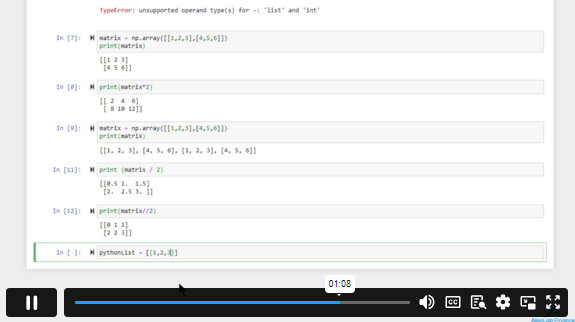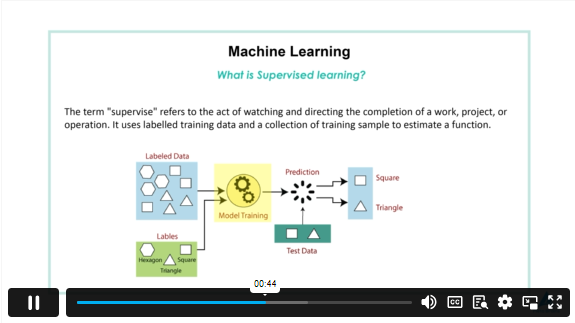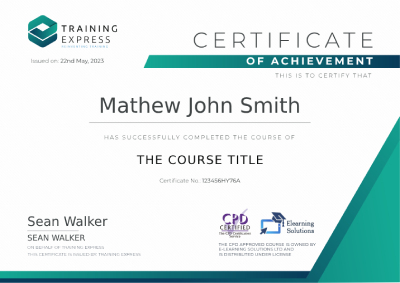Course Curriculum
| Introduction | |||
| Welcome to the Python for Data Science & ML bootcamp! | 00:01:00 | ||
| Introduction to Python | 00:01:00 | ||
| Setting Up Python | 00:02:00 | ||
| What is Jupyter? | 00:01:00 | ||
| Anaconda Installation Windows Mac and Ubuntu | 00:04:00 | ||
| How to implement Python in Jupyter | 00:01:00 | ||
| Managing Directories in Jupyter Notebook | 00:03:00 | ||
| Input & Output | 00:02:00 | ||
| Working with different datatypes | 00:01:00 | ||
| Variables | 00:02:00 | ||
| Arithmetic Operators | 00:02:00 | ||
| Comparison Operators | 00:01:00 | ||
| Logical Operators | 00:03:00 | ||
| Conditional statements | 00:02:00 | ||
| Loops | 00:04:00 | ||
| Sequences Part 1: Lists | 00:03:00 | ||
| Sequences Part 2: Dictionaries | 00:03:00 | ||
| Sequences Part 3: Tuples | 00:01:00 | ||
| Functions Part 1: Built-in Functions | 00:01:00 | ||
| Functions Part 2: User-defined Functions | 00:03:00 | ||
| Course Materials | 00:00:00 | ||
| The Must-Have Python Data Science Libraries | |||
| Installing Libraries | 00:01:00 | ||
| Importing Libraries | 00:01:00 | ||
| Pandas Library for Data Science | 00:01:00 | ||
| NumPy Library for Data Science | 00:01:00 | ||
| Pandas vs NumPy | 00:01:00 | ||
| Matplotlib Library for Data Science | 00:01:00 | ||
| Seaborn Library for Data Science | 00:01:00 | ||
| NumPy Mastery: Everything you need to know about NumPy | |||
| Introduction to NumPy arrays | 00:01:00 | ||
| Creating NumPy arrays | 00:06:00 | ||
| Indexing NumPy arrays | 00:06:00 | ||
| Array shape | 00:01:00 | ||
| Iterating Over NumPy Arrays | 00:05:00 | ||
| Basic NumPy arrays: zeros() | 00:02:00 | ||
| Basic NumPy arrays: ones() | 00:01:00 | ||
| Basic NumPy arrays: full() | 00:01:00 | ||
| Adding a scalar | 00:02:00 | ||
| Subtracting a scalar | 00:01:00 | ||
| Multiplying by a scalar | 00:01:00 | ||
| Dividing by a scalar | 00:01:00 | ||
| Raise to a power | 00:01:00 | ||
| Transpose | 00:01:00 | ||
| Element-wise addition | 00:03:00 | ||
| Element-wise subtraction | 00:01:00 | ||
| Element-wise multiplication | 00:01:00 | ||
| Element-wise division | 00:01:00 | ||
| Matrix multiplication | 00:02:00 | ||
| Statistics | 00:03:00 | ||
| DataFrames and Series in Python's Pandas | |||
| What is a Python Pandas DataFrame? | 00:01:00 | ||
| What is a Python Pandas Series? | 00:01:00 | ||
| DataFrame vs Series | 00:01:00 | ||
| Creating a DataFrame using lists | 00:03:00 | ||
| Creating a DataFrame using a dictionary | 00:01:00 | ||
| Loading CSV data into python | 00:02:00 | ||
| Changing the Index Column | 00:01:00 | ||
| Inplace | 00:01:00 | ||
| Examining the DataFrame: Head & Tail | 00:01:00 | ||
| Statistical summary of the DataFrame | 00:01:00 | ||
| Slicing rows using bracket operators | 00:01:00 | ||
| Indexing columns using bracket operators | 00:01:00 | ||
| Boolean list | 00:01:00 | ||
| Filtering Rows | 00:01:00 | ||
| Filtering rows using AND OR operators | 00:02:00 | ||
| Filtering data using loc() | 00:04:00 | ||
| Filtering data using iloc() | 00:02:00 | ||
| Adding and deleting rows and columns | 00:03:00 | ||
| Sorting Values | 00:02:00 | ||
| Exporting and saving pandas DataFrames | 00:02:00 | ||
| Concatenating DataFrames | 00:01:00 | ||
| groupby() | 00:03:00 | ||
| Data Cleaning Techniques for Better Data | |||
| Introduction to Data Cleaning | 00:01:00 | ||
| Quality of Data | 00:01:00 | ||
| Examples of Anomalies | 00:01:00 | ||
| Median-based Anomaly Detection | 00:03:00 | ||
| Mean-based anomaly detection | 00:03:00 | ||
| Z-score-based Anomaly Detection | 00:03:00 | ||
| Interquartile Range for Anomaly Detection | 00:05:00 | ||
| Dealing with missing values | 00:06:00 | ||
| Regular Expressions | 00:07:00 | ||
| Feature Scaling | 00:01:00 | ||
| Exploratory Data Analysis in Python | |||
| Introduction | 00:01:00 | ||
| What is Exploratory Data Analysis? | 00:01:00 | ||
| Univariate Analysis | 00:02:00 | ||
| Univariate Analysis: Continuous Data | 00:06:00 | ||
| Univariate Analysis: Categorical Data | 00:02:00 | ||
| Bivariate analysis: Continuous & Continuous | 00:05:00 | ||
| Bivariate analysis: Categorical & Categorical | 00:03:00 | ||
| Bivariate analysis: Continuous & Categorical | 00:02:00 | ||
| Detecting Outliers | 00:06:00 | ||
| Categorical Variable Transformation | 00:04:00 | ||
| Python for Time-Series Analysis: A Primer | |||
| Introduction to Time Series | 00:02:00 | ||
| Getting stock data using yfinance | 00:03:00 | ||
| Converting a Dataset into Time Series | 00:04:00 | ||
| Working with Time Series | 00:04:00 | ||
| Visualising a Time Series | 00:03:00 | ||
| Python for Data Visualisation: Library Resources, and Sample Graphs | |||
| Data Visualisation using python | 00:01:00 | ||
| Setting Up Matplotlib | 00:01:00 | ||
| Plotting Line Plots using Matplotlib | 00:02:00 | ||
| Title, Labels & Legend | 00:07:00 | ||
| Plotting Histograms | 00:01:00 | ||
| Plotting Bar Charts | 00:02:00 | ||
| Plotting Pie Charts | 00:03:00 | ||
| Plotting Scatter Plots | 00:06:00 | ||
| Plotting Log Plots | 00:01:00 | ||
| Plotting Polar Plots | 00:02:00 | ||
| Handling Dates | 00:01:00 | ||
| Creating multiple subplots in one figure | 00:03:00 | ||
| The Basics of Machine Learning | |||
| What is Machine Learning? | 00:02:00 | ||
| Applications of machine learning | 00:02:00 | ||
| Machine Learning Methods | 00:01:00 | ||
| What is Supervised learning? | 00:01:00 | ||
| What is Unsupervised learning? | 00:01:00 | ||
| Supervised learning vs Unsupervised learning | 00:04:00 | ||
| Simple Linear Regression with Python | |||
| Introduction to regression | 00:02:00 | ||
| How Does Linear Regression Work? | 00:02:00 | ||
| Line representation | 00:01:00 | ||
| Implementation in python: Importing libraries & datasets | 00:02:00 | ||
| Implementation in python: Distribution of the data | 00:02:00 | ||
| Implementation in python: Creating a linear regression object | 00:03:00 | ||
| Multiple Linear Regression with Python | |||
| Understanding Multiple linear regression | 00:02:00 | ||
| Exploring the dataset | 00:04:00 | ||
| Encoding Categorical Data | 00:05:00 | ||
| Splitting data into Train and Test Sets | 00:02:00 | ||
| Training the model on the Training set | 00:01:00 | ||
| Predicting the Test Set results | 00:03:00 | ||
| Evaluating the performance of the regression model | 00:01:00 | ||
| Root Mean Squared Error in Python | 00:03:00 | ||
| Classification Algorithms: K-Nearest Neighbors | |||
| Introduction to classification | 00:01:00 | ||
| K-Nearest Neighbours algorithm | 00:01:00 | ||
| Example of KNN | 00:01:00 | ||
| K-Nearest Neighbours (KNN) using python | 00:01:00 | ||
| Importing required libraries | 00:01:00 | ||
| Importing the dataset | 00:02:00 | ||
| Splitting data into Train and Test Sets | 00:03:00 | ||
| Feature Scaling | 00:01:00 | ||
| Importing the KNN classifier | 00:02:00 | ||
| Results prediction & Confusion matrix | 00:02:00 | ||
| Classification Algorithms: Decision Tree | |||
| Introduction to decision trees | 00:01:00 | ||
| What is Entropy? t | 00:01:00 | ||
| Exploring the dataset | 00:01:00 | ||
| Decision tree structure | 00:01:00 | ||
| Importing libraries & datasets | 00:01:00 | ||
| Encoding Categorical Data | 00:03:00 | ||
| Splitting data into Train and Test Sets | 00:01:00 | ||
| Results Prediction & Accuracy | 00:03:00 | ||
| Classification Algorithms: Logistic regression | |||
| Introduction | 00:01:00 | ||
| Implementation steps | 00:01:00 | ||
| Importing libraries & datasets | 00:02:00 | ||
| Splitting data into Train and Test Sets | 00:01:00 | ||
| Pre-processing | 00:02:00 | ||
| Training the model | 00:01:00 | ||
| Results prediction & Confusion matrix | 00:02:00 | ||
| Logistic Regression vs Linear Regression | 00:02:00 | ||
| Clustering | |||
| Introduction to clustering | 00:01:00 | ||
| Use cases | 00:01:00 | ||
| K-Means Clustering Algorithm | 00:01:00 | ||
| Elbow method | 00:02:00 | ||
| Steps of the Elbow method | 00:01:00 | ||
| Implementation in python | 00:04:00 | ||
| Hierarchical clustering | 00:01:00 | ||
| Density-based clustering | 00:04:00 | ||
| Implementation of k-means clustering in python | 00:01:00 | ||
| Importing the dataset | 00:03:00 | ||
| Visualising the dataset | 00:02:00 | ||
| Defining the classifier | 00:02:00 | ||
| 3D Visualisation of the clusters | 00:03:00 | ||
| 3D Visualisation of the predicted values | 00:03:00 | ||
| Number of predicted clusters | 00:02:00 | ||
| Recommender System | |||
| Introduction | 00:02:00 | ||
| Collaborative Filtering in Recommender Systems | 00:01:00 | ||
| Content-based Recommender System | 00:01:00 | ||
| Importing libraries & datasets | 00:03:00 | ||
| Merging datasets into one dataframe | 00:01:00 | ||
| Sorting by title and rating | 00:04:00 | ||
| Histogram showing number of ratings | 00:01:00 | ||
| Frequency distribution | 00:01:00 | ||
| Jointplot of the ratings and number of ratings | 00:01:00 | ||
| Data pre-processing | 00:02:00 | ||
| Sorting the most-rated movies | 00:01:00 | ||
| Grabbing the ratings for two movies | 00:01:00 | ||
| Correlation between the most-rated movies | 00:02:00 | ||
| Sorting the data by correlation | 00:01:00 | ||
| Filtering out movies | 00:01:00 | ||
| Sorting values | 00:01:00 | ||
| Repeating the process for another movie | 00:02:00 | ||
| Conclusion | |||
| Conclusion | 00:01:00 | ||
Instructors
10 STUDENTS ENROLLED
 Food Hygiene
Food Hygiene Health & Safety
Health & Safety Safeguarding
Safeguarding First Aid
First Aid Business Skills
Business Skills Personal Development
Personal Development








